|
Click here to return to Simkin/Hughes/Kershaw Family webpage |
||||||
|
||||||
|
Part One : Muriel Millicent Hughes 1914 -1939 |
||||||
|
|
Simkin/Hughes/Kershaw Family Album
Muriel Simkin's Life in Photographs
|
Muriel Simkin (Hughes) born 1914 - died 2010 |
|
Click here to return to Simkin/Hughes/Kershaw Family webpage |
||||||
|
||||||
|
Part One : Muriel Millicent Hughes 1914 -1939 |
||||||
|
|
|
[ABOVE] A portrait of Muriel Hughes as a young woman, photographed around 1935 when she would have been twenty-one years of age. This portrait was taken at the photographic studio of P. Griffiths of 98 Armagh Road, Old Ford, London, E3., four years before Muriel's marriage to John Edward ('Ted') Simkin. |
Muriel Hughes Muriel Millicent Hughes was born at No.2 Halidon Street, Hackney, London E9 on 29th July 1914. Muriel was the eldest daughter of Elizabeth Ellen Kershaw (1893-1979) and Thomas Griffiths Hughes (1880- 1954). Muriel's father, Thomas Griffiths Hughes, was born in Stoke Newington, London, on 8th October 1880, the son of Margaret and John Hughes, a blacksmith and farrier from North Wales. The second youngest of six children born to Margaret and John Hughes, Thomas Griffiths Hughes began his working life as a mercantile clerk. When he first met nineteen year old maidservant Elizabeth 'Nell' Kershaw, Tom Hughes was working in the drapery trade, either as a warehouseman or as a salesman. When Elizabeth Ellen Kershaw entered into a relationship with thirty-three year old Tom Hughes, she was a nineteen year old "lady's maid" in the employment of the famous actress Sybil Thorndike and her husband Lewis Casson, an actor and theatre director. Elizabeth Ellen Kershaw had been born in Hackney, East London, on 12th August 1893, the second eldest of thirteen children born to Anne Heath (born 1871, Hackney) and her husband James Kershaw (1870-1935), an engineer's fitter who was originally from Rochdale, Lancashire. Elizabeth 'Nell' Kershaw gave birth to a baby girl on 29th July 1914. Nell Kershaw's daughter was christened Muriel Millicent Hughes, but although Tom Hughes had given the baby girl his surname, Muriel's parents were not formally married until the Summer of 1917. The union of Thomas Griffiths Hughes and Elizabeth Ellen Kershaw produced two more children - a son named John ('Jack') James Hughes, who was born on 11th March 1920 and another daughter, Stella Amelia Hughes, who arrived some six years later on 5th June 1926. Muriel Hughes and her two siblings, Jack and Stella, were born and brought up in the parish of St John's Church in the central part of Hackney, a district to the north-east of the City of London. Halidon Street, Hackney, where Muriel Hughes was born in 1914, had been built in the late 1880s and consisted of substantial terraced buildings with small yards at the rear. When Muriel Hughes lived in Halidon Street, Hackney, the immediate neighbourhood could be described as a "respectable working-class area", yet a short distance away in Homerton, in the streets south of the Eastern Hospital, there were overcrowded slums and chronic poverty. Muriel Hughes's first two decades of life were centred around Hackney. From the age of five or six, Muriel attended The Rams Episcopal Infant School in Urswick Road, Hackney and she finished her education in 1928 at the Hackney Free & Parochial School. Leaving school in 1928, at the age of fourteen, Muriel Hughes found work at Barlow's Metal Box Factory in Hackney's Urswick Road. Four years later, in 1932, Muriel Hughes secured employment with the large tailoring firm of Horne Brothers, a company which made men's suits and trousers at premises in King Edward's Road, near Mare Street in South Hackney. |
|||||
|
|
| Muriel's Neighbourhood of Hackney in East London |
Originally a
village on the outskirts of London (The centre of Hackney is only 4 miles
north-east of Charing Cross), Hackney was transformed into an inner London
suburb with the arrival of the railway and speculative house building which
took place during Victorian times. Halidon Street, Hackney, where
Muriel Hughes was born in 1914, had been developed in the late 1880s and
consisted of substantial terraced buildings with small yards at the rear.
According to Charles Booth's "Inquiry
into the Life and Labour of the People in London",
Halidon Street was "a good, clean street with plane trees" and
the inhabitants of Halidon Street were "fairly comfortable" on "good
ordinary earnings". When Muriel Hughes lived in Halidon
Street, Hackney in the 1920s, the immediate neighbourhood was considered
to be "a respectable
working-class area". However, Hackney was then an area of sharp social
contrast. There were dirty, overcrowded slums in the streets south of the
Eastern Hospital in the nearby district of Homerton, yet on the
western side of Urswick Road in the streets which led to St John's
Church there were rows of handsome houses belonging to the middle-class
residents of Hackney. The chapter devoted to 'Hackney, Homerton and Hackney
Wick' in A History of the County of
Middlesex confirmed that "the well-to-do (residents of Hackney)
were confined to Urswick Road and its western offshoots St.
John's Church Road and Sutton Place".
|
[ABOVE] Photo 1. Halidon Street, Hackney, the street where Muriel Hughes was born and brought up in the years following the First World War. This photograph labelled "Halidon Street, Lower Clapton" is taken from a picture postcard published around 1910. Charles Booth's Inquiry into the Life and Labour of the People in London, published in 1903, described Halidon Street as "a good, clean street with plane trees".
[ABOVE] The location of Halidon Street (shaded in yellow) in the district of Hackney, East London, as shown in a map produced by Charles Booth in 1899 to show areas of poverty in London. Charles Booth's "Maps Descriptive of London Poverty" were coloured to indicate the income and social class of its inhabitants. The dark blue shading represented "very poor" areas of "chronic want". The houses in Halidon Street were shaded pink to indicate that the inhabitants were "fairly comfortable" on "good ordinary earnings". Urswick Road (see Photo 2, above left) formed a boundary between the respectable working-class area around Halidon Street (Photo 1, top) and the affluent middle-class area leading to St John's Church (Photo 3, left). Opposite Halidon Street, on the other side of Urswick Road was St John's Church Road, the buildings of which were shaded red on Booth's London map to indicate a "middle-class" and "well-to-do" areas. The buildings of Hackney's Union Workhouse (Photo 4.see below) can be seen at the top, right-hand corner of the map, next to the Fever Hospital (later known as Eastern Hospital).
[ABOVE] Photo 4. The casual ward of the Hackney Union Workhouse. Muriel Hughes recalled that as a child she would gather up discarded cigarette ends for the old men residing at the Hackney Workhouse. Muriel remembered that the old men were always friendly and polite towards her and were grateful for the cigarette ends which would supply them with an amount of tobacco that could be rolled into fresh cigarettes. Muriel also remembered the disabled inmates with useless legs who had to move around on wheeled boards, propelled by their arms.
|
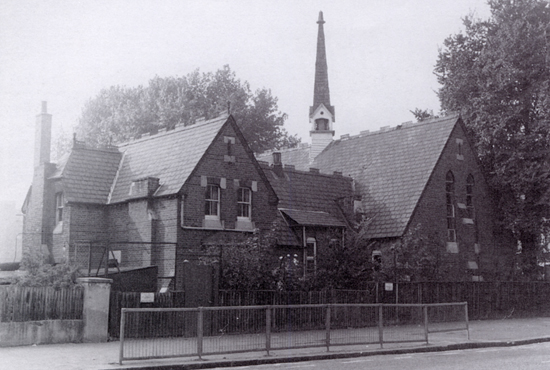 [ABOVE] The Rams Episcopal Infant School, Hackney, where Muriel Hughes attended school between 1920 and 1924. Rams Episcopal Infant School was situated on the corner of Tresham Road and Urswick Road in Hackney. Built in 1871, the school was originally one of the Rams Episcopal Chapel Schools. The school building was demolished in 1972. |
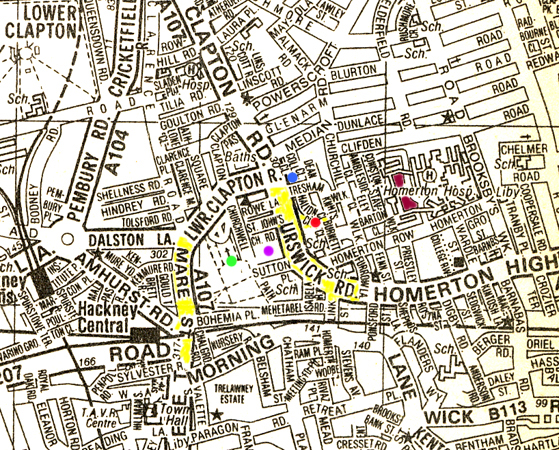 |
||||||||||||||||||
| [ABOVE RIGHT] A Modern Map of Hackney showing the streets and the sites of buildings mentioned in the text. Halidon Street, where Muriel Hughes lived as a young girl no longer exists, but it is indicated on the map by a red dot near the modern Halidon Close. The Metal Box Factory (once situated north of Sutton Place), Hackney Union Workhouse and the Rams Episcopal Infant School have all been demolished and replaced by modern buildings. |
|
||||||||||||||||||
Muriel's School Days
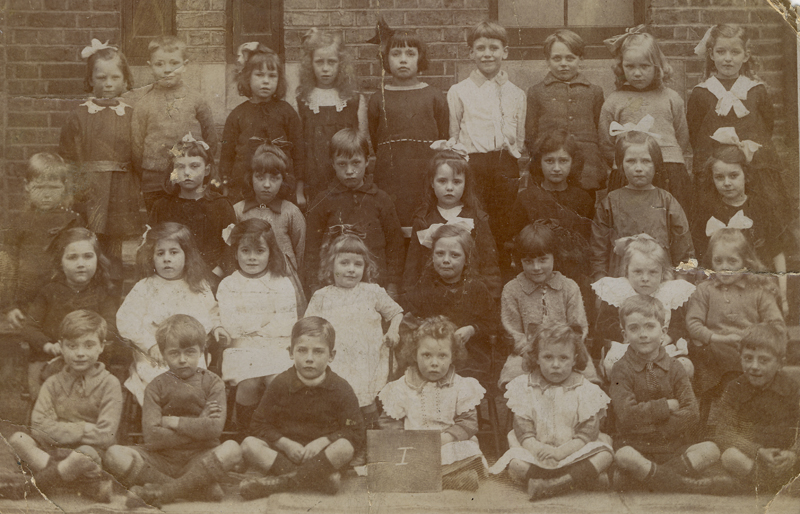 |
|
||
| [ABOVE] Muriel Hughes (on the far left of the top row) posing with her classmates in a group photograph taken at The Rams Episcopal Infant School, Hackney, around 1920, when Muriel would have been around six years of age. Some 85 years later, Muriel was able to identify many of the children in this school group photograph. Muriel's best friend, Mildred Simmons (dressed in dark clothing and without a bow in her hair) stands third from right in the third row from the front. | [ABOVE] Muriel Hughes, aged about six, pictured in a detail from a school group photograph taken around 1920 at The Rams Episcopal Infant & Primary School, Urswick Road, Hackney, London. | ||
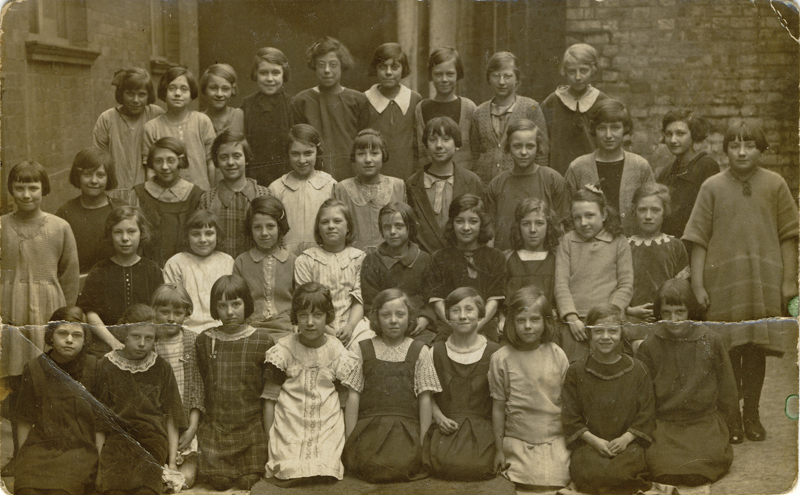 [ABOVE] A school group photograph taken around 1925, showing the thirty-nine girls in Muriel Hughes's class at the Hackney Free & Parochial School in East London. Mildred Simmons Muriel's best friend since infant school is standing on the far right in the third row from the front. |
[ABOVE] Muriel Hughes, aged about eleven, pictured in a detail from a school group photograph taken around 1925.
[ABOVE] Mildred Simmons, Muriel's best friend at school |
|
Muriel and her Family on a Sunday Outing in 1928 |
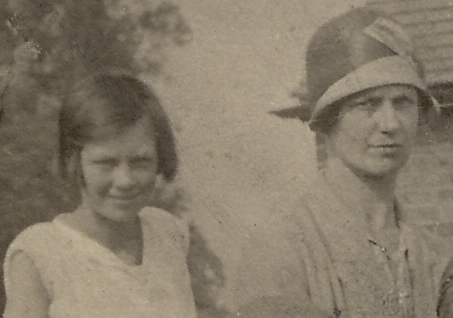 |
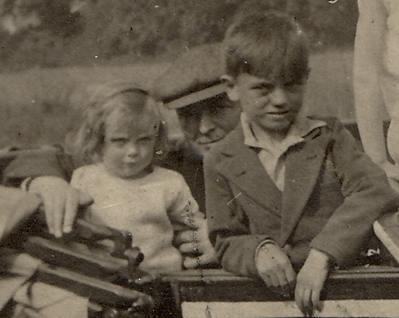 |
|
| [ABOVE] Muriel Hughes, aged about fourteen, pictured with her mother Mrs Elizabeth 'Nell' Hughes in a detail from a photograph taken around 1928.( See the photograph of the charabanc outing below). Muriel Hughes started work at Barlow's Metal Box factory in the same year that this photograph was taken. | [ABOVE] Tom Hughes, Muriel's father, seated in the rear of the charabanc with Muriel's siblings two year old Stella Hughes and eight year old John 'Jack' Hughes, pictured in a detail from a photograph taken around 1928.( See the photograph of the chara-a-banc outing below). | |
|
|
||
|
Muriel's Brother and Sister - 'Jack' John Hughes and Stella Hughes |
||
|
|
|
|
| Muriel Millicent Hughes, who was born on 29th July 1914. Muriel was nearly six years older than her brother Jack and a dozen years older than her sister Stella. | John ('Jack') James Hughes, who was born in Hackney, East London, on 11th March 1920. | Stella Amelia Hughes, who was born in Hackney, East London, on 5th June 1926. |
|
Edward C. Barlow & Son's Metal Box Factory in Hackney |
|
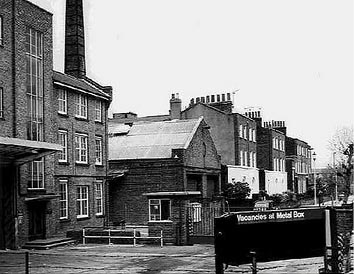 [ABOVE] The Metal Box Factory at Sutton Place, Urswick Road, Hackney, as shown in a photograph taken in the early 1970s. The original factory was established in Hackney in 1903 by Edward Charles Barlow (1846-1937) a tin box manufacturer from Stoke Newington. Subsequently owned by the firm of Edward C. Barlow & Sons, the factory became part of the Metal Box Company Limited in 1930. |
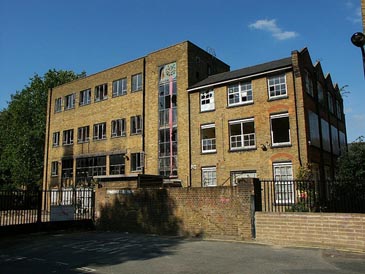 [ABOVE] A modern photograph of the former Metal Box Factory at 23-25 Sutton Place, Hackney, London. The original building (in this photograph derelict and covered in graffiti and awaiting demolition) was, in the early 1900s, Edward Barlow's metal box factory. In 1930, the factory became part of The Metal Box Company Limited. [PHOTO: Bunch & Duke, Chartered Surveyors, Hackney] |
 [ABOVE] A photograph dating from 1909 showing the interior of an American tin can factory with women operating machinery. A similar scene could have been pictured inside Edward Barlow's Metal Box factory in Hackney, East London, during the first few decades of the 20th century.
[ABOVE] Stamping out the end discs at an American food-can factory in 1909. Noisy, heavy machinery was used at Edward Barlow's tin box factory during the first few decades of the 20th century. Robert Barlow introduced the latest American machinery at the Metal Box Company's factory in Sutton Place, Hackney, during the early 1930s. A former worker at the Metal Box factory in Hackney later recalled : "The noise from this place was constant. Clattering and crashing of conveyor belts as they made tins. I can still hear the noise in my head . The factory went as far back as St Johnís Church Road and those living on the South side must have had little sleep". |
The firm of
Edward Charles
Barlow & Sons was founded by
Edward Charles Barlow (1846-1937), a poorly educated, but ferociously
ambitious metal box maker from the East End of London. Edward Charles
Barlow was born in Hackney Road in the London district of Shoreditch in
1846. The 1881 census records Edward C. Barlow, then a thirty-four year old
widower, as a "Tin Box Maker" of Shoreditch. In a London Commercial
Directory published in 1895, Edward Charles Barlow is described as a maker
of tins for mustard, coffee, infants' food, preserves, paints and syrups.
Around 1903, Edward Barlow had
established a factory making metal boxes and tins in the London district of
Hackney. Situated on land on the west side of Hackney's Urswick Road, immediately north of Sutton Place,
Barlow's tin box factory became one of Hackney's largest employers. By 1915,
Edward Barlow had brought his two sons into the business and the tin box
factory in Urswick Road, Hackney went under the name of Edward
Charles
Barlow & Sons. From 1930, the factory at Sutton Place, near Urswick Road, Hackney went under the name of the Metal Box Company. The parent company Allied Tin Box Makers Limited, an amalgamation of British businesses manufacturing metal containers, had been formed in 1921. Generally known as the Metal Box Company, this group of manufacturers was joined by Edward C. Barlow & Sons in 1929. The following year, the Metal Box group became The Metal Box Company Limited. Edward Charles Barlow, the founder of Edward C. Barlow & Sons, had been described by contemporaries as 'a tough, sometimes terrifying, Cockney, barely literate'. Another writer summarised Edward Barlow's character as "almost illiterate, fond of women, violent if crossed, an autocrat in his business". Edward Barlow's son, Robert Barlow (1891-1976) was better educated, but just as ruthless and ambitious as his father. Robert Barlow also shared his father's volatile temper and autocratic methods. W. J. Reader, the historian of the Metal Box Company, describes Robert Barlow as a strong, forceful character who was "ruthless, cunning and devious", and directed by a high intelligence "clothed in overwhelming charm". A Director of the Metal Box Company in 1930, Robert Barlow resisted attempts by the American Can Company to control can-making in Britain. Using manufacturing methods modelled on the American canning industry and introducing machinery based on American technology, Robert Barlow built up a British-owned, can-making industry. The factory of Edward C. Barlow & Sons (later merged with the Metal Box Company) provided employment to large number of Hackney's inhabitants. Muriel Hughes (born 1914, Hackney) who started working at the age of fourteen at the works in Sutton Place, Urswick Road, Hackney was one of hundreds of girls and young women who earned their living by operating machinery in the Barlow's metal box factories. Sir Robert Barlow, who was knighted for his services to trade and industry during the Second World War, rose to become Chairman of The Metal Box Company Limited. In 1942 (the year before he was knighted), Robert Barlow married the distinguished British actress Margaret Rawlings (1906-1996). |
|
|
| Muriel Begins Her Working Life |
|
[ABOVE] Muriel Hughes, aged about sixteen, when she was working at Barlow's Metal Box Factory in Hackney on a wage of 5s 6d a week. On her first day at the factory, her mother insisted that Muriel wear her "Velour" school hat to work. The headgear had been purchased for school wear, but "as the hat had cost money, she had to make use of it". As she left the house wearing the hated school hat, Muriel was told by her mother to look after the hat as it was "expensive". Muriel feared the worst when, on her first day at work, the hat was blown off her head by a gust of wind and went under the wheels of a lorry.
[ABOVE] In the early 1930s, Muriel Hughes worked at the Venus Pencil Company factory in Lower Clapton Road in East London. Seventy years later, Muriel could show a piece of graphite under the skin of her hand, where she had been stabbed with a pencil by an angry co-worker. |
Muriel Hughes left school in the
Summer of 1928, at the age of fourteen. Muriel found work at Barlow's
Metal Box Factory in Hackney, East London.
The firm of Edward C. Barlow & Sons had established a factory making metal boxes and cans on land immediately north of Sutton Place in Hackney around 1903. Edward Barlow, the founder of the firm, was described by an historian as 'a tough, sometimes terrifying, Cockney, barely literate'. In 1929, the firm of Edward C. Barlow & Sons had joined forces with a number of other companies which manufactured metal containers to form the Metal Box Company Limited. Interviewed in old age, Mrs Muriel Simkin recalled her life as a teenage worker at Barlow's Metal Box Factory in Hackney. Muriel Hughes worked from 8 am to 6pm, making the hour's journey to the factory on foot to save the penny which could have been spent on the tram fare. In 1928, Muriel earned 5s 6d a week at the Metal Box factory. She recalled how after a week's labour, she kept one shilling for herself and handed over the remaining 4s 6d to a mother for "housekeeping". Muriel, who had presumably by then had moved away from Halidon Street to Lea Bridge Road, left her house at 7am to walk the three or four miles to the Metal Box factory, ready to start work at 8 am.
At the age of 17 or 18, Muriel left Barlow's Metal Box Factory to work in the factory of The Venus Pencil Company Limited, which was located in Lower Clapton Road, East London. An American owned company, the Venus Pencil Company had acquired a factory in Lower Clapton Road in 1910. Long after she retired, Muriel showed me a piece of graphite that was still lodged under the skin of her hand, where she had been stabbed with a pencil by an angry co-worker. Around 1932, Muriel Hughes found a better-paid and more rewarding job at the well-known tailoring firm of Horne Brothers, a company which made men's suits and trousers at premises in King Edward's Road, near Mare Street in South Hackney. Muriel's starting wage at Horne Brothers was 6s 6d a week, but when she was promoted to the position of "Examiner and Finisher" at the tailoring firm, her weekly wage was raised to 7s 6d. Even when her wages were increased to 8s 6d a week, Muriel would still only keep a shilling to spend on herself, giving the balance of 7s 6d to her mother towards "housekeeping". Before setting off to work at Horne Brothers, Muriel would fix her Dad's breakfast. ( As a commercial traveller, Tom Hughes did not start work until 10 am).
|
|||||
| Mare Street, South Hackney |
|
[ABOVE] Mare Street, South Hackney, one of Hackney's main business and shopping areas (1904). Horse-drawn trams served Mare Street right up until 1912. From around 1934, Muriel Hughes worked at the tailoring firm of Horne Brothers which was situated in King Edward's Road, off Mare Street . |
|
| Muriel Hughes and 'Ted' Simkin |
|
Muriel Hughes first met
John Edward Simkin in 1934, when she was sent round to his flat in
Garnham Street, Stoke Newington to show his mother where the radio
aerial was located. The flat in Garnham Street had been previously occupied
by Muriel's uncle, Joseph Hughes (born 1884, Stoke Newington), so
Muriel had a good knowledge of the flat. The flat in Garnham Street was occupied by Mrs Jane White, a twice widowed fifty year old woman and her two sons from her first marriage - John Edward Simkin junior (born 1914, London) and William Valentine Simkin (born 1915, Islington, London) and a daughter Lily White (born 1920, Stoke Newington, London) from a second marriage to Harry White. In 1910, Jane Hopkins (later Mrs White) had married John Edward Simkin senior (born 1883, Stepney, London), an envelope cutter. Jane had given birth to a daughter named Elsie Simkin early in 1912, but the girl had died at the age of three. On 17th January 1914, Jane gave birth to a healthy baby boy, who was christened John Edward Simkin, but in adult life was generally known as 'Ted' to family and friends. Ted Simkin's younger brother, William Valentine Simkin was born on 14th February, 1915, but his father John Simkin never saw his second son. John Edward Simkin senior, who was serving as a soldier with the East Kent Regiment in France, was killed in an explosion while tunnelling under German lines on 29th August 1915. After the death of her husband in the First World War, Mrs Jane Simkin (born 1883, Hoxton, London) began a liaison with a man named Harry White and reportedly later married him. When in 1934, Muriel Hughes paid Mrs White a visit at the flat in Garnham Street, Mrs Jane White was living with her two sons, twenty year old 'Ted' Simkin and nineteen year old 'Bill' Simkin (then generally known as "Willie White") and their half-sister, fourteen year old Lily White. Both of Mrs White's sons showed an interest in twenty year old Muriel. 'Bill' Simkin wanted to ask her out and his older brother Ted Simkin told his mother, after Muriel's first visit to the flat in Stoke Newington, that he had just met "the girl he was going to marry". Muriel Hughes was not very experienced in matters of the heart. The only 'serious' relationship she had ever had was with a co-worker name Tom Heath, whom she had met when eighteen or nineteen years of age. Tom Heath, at twenty-six, was regarded as an "older man" and proved to be too "worldly wise" for the innocent teenager. Meeting Ted Simkin and his young brother Bill on the street, Muriel was invited out on a date by both young men. Ted Simkin proved more persistent than his brother and Muriel Hughes eventually agreed to accompany him to "the pictures". |
The Courtship of Muriel Hughes
and 'Ted' Simkin
|
|
Muriel and Ted's First Date |
|
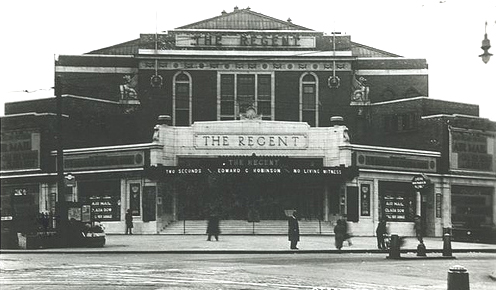 [ABOVE] The Regent Cinema Theatre, Amhurst Park, Stamford Hill, photographed in 1932 This cinema opened to the public in February 1929. Muriel Hughes went to the Regent Cinema on her first proper date with Ted Simkin in 1935 to see the film "Mutiny on the Bounty". ( See the film poster for "Mutiny on the Bounty" on the right ). Later known as The Gaumont Cinema (1960) and the Odeon Cinema (1962), the cinema in Stamford Hill closed in 1972 and was demolished in 1984. |
[ABOVE] A publicity poster for "Mutiny on the Bounty", a 1935 film starring Charles Laughton as Captain Bligh and Clark Gable as Fletcher Christian. |
|
Ted and Muriel's Courting Days |
||||||||
|
|
|
||||||
|
|
|
||||||
|
The Marriage of Muriel Hughes and 'Ted' Simkin - 26th August 1939 |
||||
Muriel Millicent Hughes (born 1914, Hackney) married
John Edward 'Ted' Simkin (born 1914, London) at West Hackney Church,
Stoke Newington on 26th
August 1939, less than a week before the outbreak of the Second World War.
Shortly after their wedding, Ted and Muriel Simkin went away on honeymoon to the Dorset seaside resort of Weymouth. A week into their honeymoon, the British Government declared war on Hitler's Germany and the couple were compelled to return to their home in Dagenham. Muriel and her husband were living at 98 Rogers Road, Dagenham, when Ted Simkin was called up to join the armed forces. For the duration of the war, Ted Simkin served in the Royal Artillery, manning the anti-aircraft batteries on the south coast of England. Muriel Simkin performed her 'war work' at the Briggs Munitions Factory in Dagenham. |
[ABOVE] The official wedding photograph marking the marriage of Muriel Hughes to John Edward 'Ted' Simkin, photographed by Louis Edward Muller of Hackney on 26th August, 1939. Louis Edward Muller, who was born in Germany in 1876, ran a photographic studio at 454 Kingsland Road, Hackney from around 1907 until the Second World War.
[ABOVE] The headline on the front page of the Evening Standard newspaper (1st September 1939) reporting the German invasion of Poland and the threat of war. Britain's declaration of war two days later brought Ted and Muriel's honeymoon to an abrupt end. |
|||
|
The Marriage of Muriel Hughes and 'Ted' Simkin: Wedding Photographs (26th August 1939) |
||
|
|
|
|
|
[ABOVE] Muriel Hughes and Ted Simkin on their wedding day in August 1939, photographed in the back yard of Muriel's family home in Hackney by Sid Matthews, a friend of Muriel's brother Jack. |
[ABOVE] Muriel Hughes photographed in the back garden of her parents' home on 26th August 1939, the day of her marriage to John 'Ted' Edward Simkin. This snap was photographed by a family friend. The official wedding photograph was taken in the photographic studio of Louis Edward Muller of 454 Kingsland Road, Hackney, East London. | [ABOVE] Muriel and Ted Simkin's wedding cake , photographed by a professional photographer on the day of their wedding (26th August 1939). The photographer was probably Louis Edward Muller of 454 Kingsland Road, Hackney, East London. |
|
|
| [ABOVE] The wedding of Muriel Simkin and John 'Ted' Edward Simkin. This photograph of the happy couple was made into a postcard which could be sent to friends and relatives. |
|
The next instalment of Muriel Simkin's Life Story can be read by clicking on the link below :
Part Two : Mrs Muriel Simkin 1939-1964
|
Click on the link below to read the next instalment of the story of Muriel Simkin's life, covering the years of her marriage and the birth of her children : |
|||||
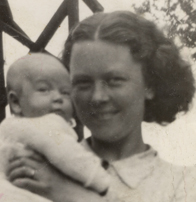 |
|
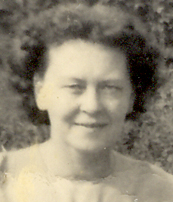 |
|
|
|
|
Part Three : Mrs Muriel Simkin 1964-2010 |
|||||
|
|
|
|
|
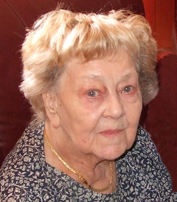 |
|
|
Acknowledgements & Sources |
| Inquiry into the Life and Labour of the People in London by Charles Booth (1903). Charles Booth's "Maps Descriptive of London Poverty (1899); .Strength in the Tower : An Illustrated History of Hackney by David Mander (Sutton Publishing, 1998); A Hackney Century, 1900-1999 by David Mander (Sutton Publishing, 1999). Material on Hackney featured on the Flicker pages compiled by "ex_ackney_lad"; |
Click here to return to Simkin/Hughes/Kershaw Family webpage